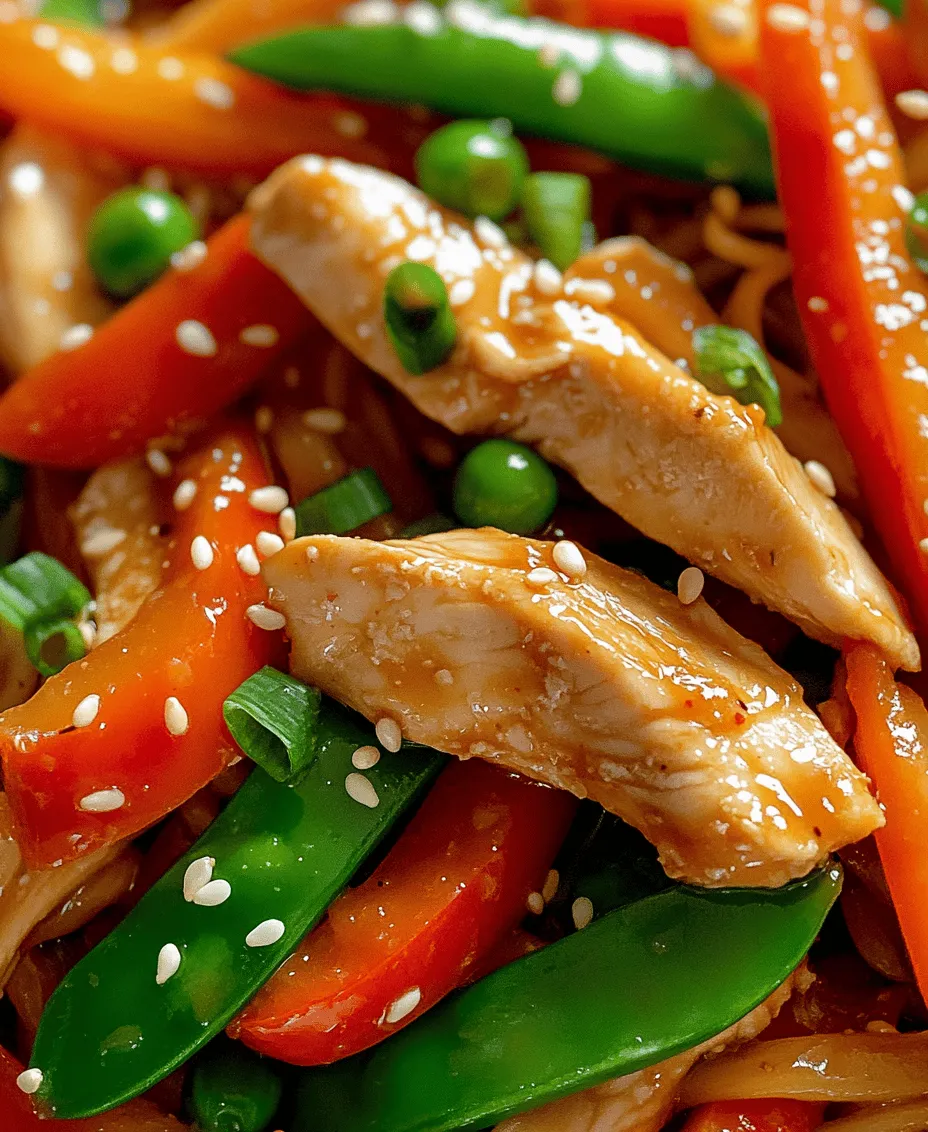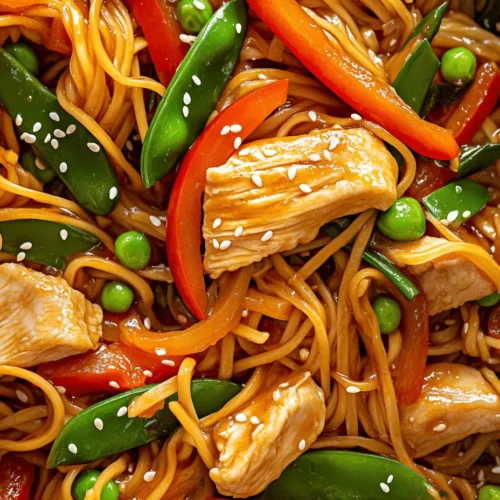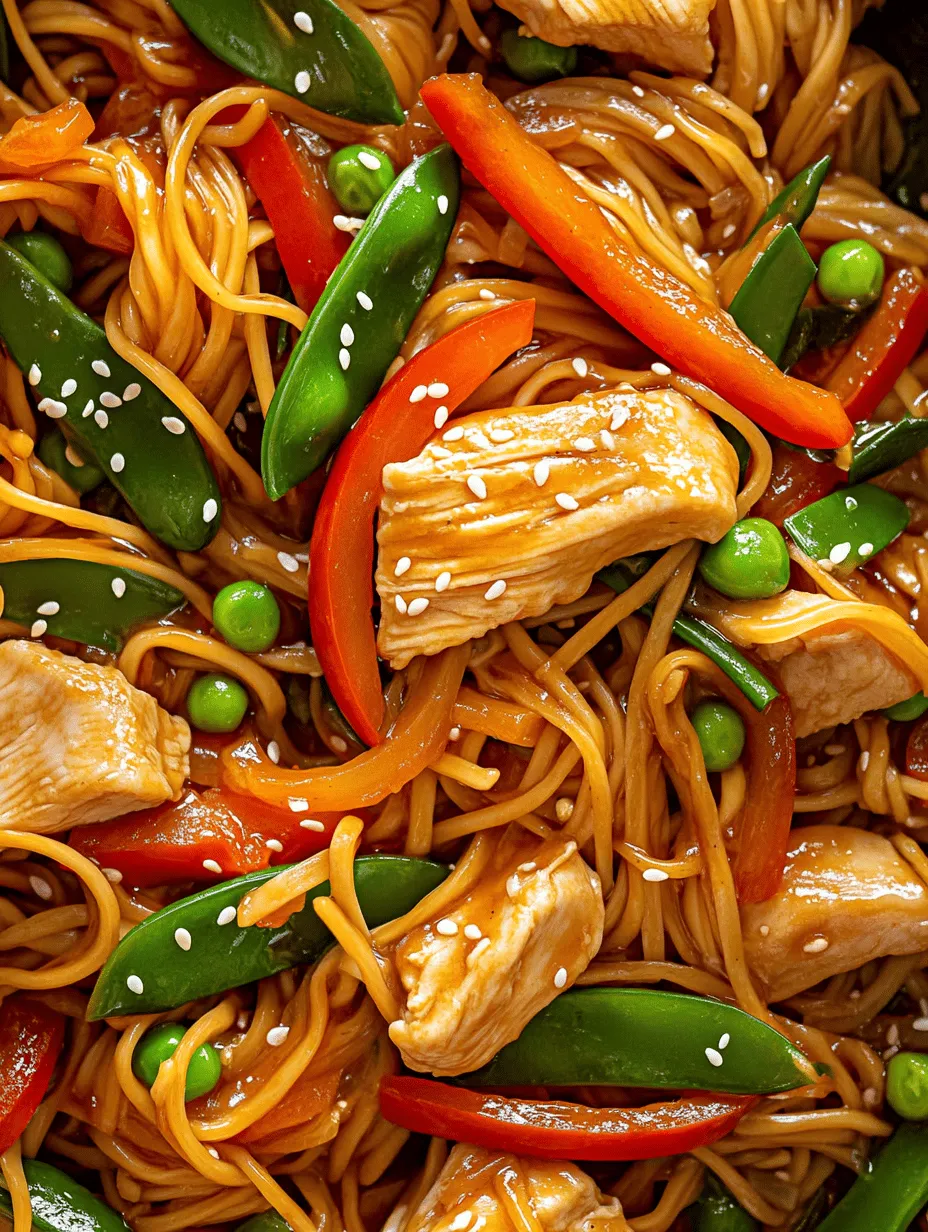Introduction
Chicken Chow Mein is more than just a dish; it’s a beloved staple in Asian cuisine that has captured the hearts and palates of food lovers worldwide. Known for its delightful array of flavors and textures, this stir-fried noodle dish is a perfect blend of tender chicken, vibrant vegetables, and savory sauces, all tossed together to create a comforting meal that’s both satisfying and delicious. While you might often find Chow Mein in your favorite Chinese restaurant, making it at home brings a unique sense of accomplishment and allows you to tailor the flavors to your liking.
One of the joys of preparing Chicken Chow Mein at home is the convenience it offers. In just a short amount of time, you can whip up a quick and nutritious meal that rivals takeout. The dish is not only easy to make but also provides an excellent opportunity to experiment with various ingredients, ensuring a personalized taste experience. The balance of crispy vegetables, tender chicken, and chewy noodles makes this recipe a delight for the senses, making it a favorite among families and friends alike.
Understanding Chow Mein
Definition and Origin of Chow Mein
Chow Mein, which translates to “stir-fried noodles” in Cantonese, is a dish that has its roots in Chinese cuisine. It is believed to have originated in the late 19th century in the United States, where Chinese immigrants began adapting traditional recipes to suit local tastes. The dish typically consists of wheat noodles stir-fried with a mix of meat and vegetables. Over time, Chow Mein has evolved into various forms and styles, making it a versatile option on many Asian menus.
Popular Variations Across Different Cultures
While the traditional Chow Mein features crispy noodles stir-fried with an assortment of ingredients, there are numerous variations that reflect the diverse culinary practices across Asia. For instance, in the Philippines, a unique version known as “Pancit Canton” includes a mix of seafood and vegetables, while in India, Chow Mein may incorporate spices and local ingredients. Each culture adds its twist, showcasing the adaptability of this classic dish.
Importance of Chow Mein in Asian Culinary Traditions
Chow Mein holds a significant place in Asian culinary traditions, often served during celebrations and gatherings. It’s a dish that embodies the essence of communal dining, where families come together to share a hearty meal. The preparation and consumption of Chow Mein also highlight the importance of balance and harmony in Asian cooking, symbolizing the blend of flavors that contribute to overall well-being.
Ingredients Breakdown
To prepare a mouthwatering Chicken Chow Mein, it’s essential to understand the key ingredients that make this dish so special.
Chicken: Benefits of Using Boneless, Skinless Chicken Breast
The star of this recipe is the chicken, and using boneless, skinless chicken breast is highly recommended. This choice not only provides a lean source of protein but also cooks quickly, making it ideal for stir-frying. Boneless, skinless chicken breast is tender and absorbs flavors well, ensuring every bite is delicious. Moreover, it’s easy to slice into thin strips, which allows for even cooking and a delightful texture in the final dish.
Vegetables: Nutritional Value of Bell Peppers, Carrots, Snap Peas, and Bean Sprouts
A colorful medley of vegetables is integral to Chicken Chow Mein, adding not only flavor but also a wealth of nutrients. Here’s a closer look at the key vegetables used in this recipe:
– Bell Peppers: Available in a variety of colors, bell peppers are rich in vitamins A and C, contributing to immune support and skin health. Their natural sweetness adds a lovely contrast to the savory elements of the dish.
– Carrots: Packed with beta-carotene, which the body converts into vitamin A, carrots provide a crunchy texture and a mild sweetness. They are also high in antioxidants, promoting good vision and overall health.
– Snap Peas: These sweet and crunchy legumes add a refreshing element to the dish. They are a great source of vitamins K and C, as well as fiber, making them a nutritious addition.
– Bean Sprouts: A staple in many Asian dishes, bean sprouts bring a delightful crunch and a subtle nutty flavor. They are low in calories yet rich in vitamins, making them an excellent choice for enhancing the nutritional profile of your meal.
Noodles: Differences Between Chow Mein and Lo Mein Noodles
The type of noodles used is crucial in defining the dish. Chow Mein typically uses thin, crispy noodles that are stir-fried until golden brown, while lo mein noodles are thicker and softer, tossed with sauce rather than fried. This recipe will focus on Chow Mein noodles, which provide that signature crunch that distinguishes this dish. If you can’t find Chow Mein noodles, thin rice noodles can be a suitable alternative, though the texture will differ slightly.
Explanation of Sauces
The sauces used in Chicken Chow Mein play a vital role in flavor development, creating a harmonious blend of savory, sweet, and umami notes. Here’s a look at the key sauces that will elevate your dish:
– Soy Sauce: A staple in Asian cooking, soy sauce adds depth and saltiness. Opt for low-sodium soy sauce to control the salt levels in your dish.
– Oyster Sauce: This rich, slightly sweet sauce enhances the umami flavor and adds a glossy finish to the noodles.
– Hoisin Sauce: Known for its sweet and tangy flavor, hoisin sauce contributes a unique taste that balances the savory elements of the dish.
– Sesame Oil: Just a dash of sesame oil can impart a nutty aroma and flavor, enhancing the overall sensory experience of the dish.
– Chicken Broth: Using chicken broth instead of water when cooking the noodles or stir-frying the ingredients adds an extra layer of flavor, ensuring that each component of the dish is infused with taste.
Preparing for Cooking
Before diving into the cooking process, it’s essential to prepare all your ingredients properly. This step will not only streamline your cooking but also enhance the flavors of the dish.
Importance of Marinating the Chicken
Marinating the chicken is a critical step that elevates the flavor profile of your Chicken Chow Mein. A simple marinade made from soy sauce, sesame oil, and a dash of garlic will tenderize the chicken, allowing it to absorb the flavors deeply. The marination process also helps in achieving a juicy texture, ensuring that every bite is flavorful and moist. Aim to marinate the chicken for at least 30 minutes, or longer if you have the time; this will allow the flavors to penetrate more thoroughly.
Preparing the Chow Mein Sauce
Creating the Chow Mein sauce is straightforward and sets the stage for the rich flavors of the dish. Here’s how to prepare the sauce step-by-step:
1. In a small bowl, combine 2 tablespoons of soy sauce, 1 tablespoon of oyster sauce, 1 tablespoon of hoisin sauce, and 1 teaspoon of sesame oil.
2. Add 1/4 cup of chicken broth to the mixture.
3. Whisk the ingredients together until well combined.
4. Taste and adjust the flavors as needed, adding more soy sauce for saltiness or more hoisin sauce for sweetness.
Having this sauce ready before you start cooking will allow for a seamless stir-frying process, ensuring that the noodles and vegetables are evenly coated in flavor.
Cooking Process
Now that you have all your ingredients prepped and your sauce ready, it’s time to bring everything together in the cooking process. Here’s a step-by-step guide to cooking Chicken Chow Mein:
1. Heat the Oil: Start by heating a large wok or a deep frying pan over medium-high heat. Add 2 tablespoons of vegetable oil, allowing it to get hot but not smoking.
2. Cook the Chicken: Add the marinated chicken to the hot oil, spreading it out to ensure even cooking. Stir-fry for about 5-7 minutes, or until the chicken is cooked through and lightly browned. Remove the chicken from the pan and set aside.
3. Stir-Fry the Vegetables: In the same pan, add another tablespoon of oil if needed, then toss in the bell peppers, carrots, and snap peas. Stir-fry for about 3-4 minutes, or until the vegetables are vibrant and slightly tender but still crisp.
4. Add Noodles and Sauce: Add the cooked Chow Mein noodles to the pan along with the prepared sauce. Toss everything together, ensuring the noodles and vegetables are evenly coated.
5. Combine Chicken and Garnish: Return the cooked chicken to the pan and mix well. Stir-fry for an additional 2-3 minutes to heat everything through.
6. Finish with Bean Sprouts: Just before serving, toss in a handful of bean sprouts for added crunch and freshness.
With these steps, you’ll create a delicious Chicken Chow Mein that embodies the essence of homemade Asian cuisine, ready to be enjoyed by family and friends alike. Stay tuned for the next part of this recipe, where we will explore tips for achieving the best results and answer some common questions about this delightful dish.

Marinating the Chicken
To ensure that your Chicken Chow Mein has an irresistible flavor, marinating the chicken is essential. This step not only enhances the taste but also ensures an even distribution of flavors throughout the meat.
Tips for Ensuring Even Flavor Distribution:
1. Choose the Right Marinade: A combination of soy sauce, sesame oil, garlic, and ginger works beautifully for chicken. This mixture not only infuses the chicken with flavor but also tenderizes it. For an extra kick, consider adding a splash of rice vinegar or a dash of chili sauce.
2. Cut Chicken into Uniform Pieces: For the best results, slice your chicken into even, bite-sized pieces. This ensures that every piece absorbs the marinade equally and cooks at the same rate.
3. Marinate Time: Allow the chicken to marinate for at least 30 minutes, but for optimal flavor, aim for 2-4 hours. If time permits, marinating overnight in the refrigerator will yield the best results.
4. Use a Sealable Bag or Bowl: Place the chicken and marinade in a sealable plastic bag or a bowl covered with plastic wrap. This allows the marinade to coat the chicken evenly and prevents any spills.
Cooking Noodles
Cooking the noodles properly is another crucial step in making Chicken Chow Mein. The goal is to achieve a perfect texture that complements the stir-fried ingredients.
Best Practices for Achieving the Perfect Texture:
1. Choose the Right Noodles: Opt for egg noodles or chow mein noodles, as they provide the best texture and flavor. Fresh noodles will yield a softer bite, while dried noodles will be slightly firmer.
2. Boil in Plenty of Water: Use a large pot with ample boiling water. This prevents the noodles from sticking together. Add a pinch of salt to the water for flavor.
3. Cook Al Dente: Follow the package instructions but aim to cook the noodles al dente, as they will continue to cook during the stir-frying process. Drain the noodles and rinse them under cold water to stop the cooking process and prevent sticking.
4. Toss with Oil: After draining, toss the noodles with a teaspoon of oil to keep them separate and add a hint of flavor.
Stir-Frying Chicken
Getting the chicken just right is essential for a balanced Chicken Chow Mein.
Techniques for Achieving a Golden, Flavorful Chicken:
1. Preheat the Wok or Pan: Heat your wok or a large frying pan over high heat before adding oil. A well-heated surface ensures a nice sear on the chicken, locking in flavors.
2. Use the Right Oil: Choose oils with a high smoke point, such as canola or peanut oil. This allows for a higher cooking temperature without burning.
3. Avoid Overcrowding: Cook the chicken in batches if necessary. Overcrowding the pan can lead to steaming instead of frying, preventing that desired golden crust.
4. Stir-Fry Technique: Cook the chicken for about 4-6 minutes, stirring frequently until it turns golden brown and is cooked through. Remove it from the pan and set it aside while you prepare the vegetables.
Sautéing Vegetables
To keep the vegetables vibrant and crisp, sautéing them properly is key.
How to Maintain Crispiness and Vibrant Color:
1. Use Fresh Vegetables: Fresh vegetables like bell peppers, snap peas, and carrots not only add flavor but also color to your dish. Cut them into uniform sizes for even cooking.
2. High Heat Cooking: Just like with the chicken, ensure your pan is hot before adding the vegetables. This will help sear them quickly without making them soggy.
3. Timing is Everything: Start with the vegetables that take longer to cook, such as carrots and bell peppers, before adding quicker-cooking ones like bean sprouts or green onions. A total sauté time of about 3-5 minutes should keep them crisp.
Combining Flavors
Now that all your ingredients are prepared, it’s time to bring them together.
Importance of Timing: When to Add Each Ingredient for Maximum Flavor:
1. Add Ingredients in Stages: Start by adding the cooked chicken back into the pan, followed by the sautéed vegetables. This helps to meld their flavors before the noodles are introduced.
2. Adding the Noodles: Gently fold in the noodles last, so they don’t break apart during cooking.
Techniques for Combining Chicken, Vegetables, and Noodles:
1. Tossing Method: Use a spatula or tongs to gently toss all ingredients together. This ensures even coating of sauce and prevents the noodles from becoming mushy.
2. Sauce Integration: Pour your prepared sauce over the mixture and continue tossing until everything is well coated.
Final Presentation
A great dish deserves an equally appealing presentation.
Suggestions for Garnishing and Serving:
1. Visual Appeal: Serve your Chicken Chow Mein in a large bowl or on a platter. Arrange the noodles and chicken in the center, surrounded by colorful vegetables for a beautiful display.
2. Garnishing: Sprinkle sesame seeds and freshly chopped cilantro on top just before serving to add texture and color. You can also add lime wedges on the side for a fresh, zesty touch.
3. Serving Suggestions: Pair your Chow Mein with a side of spring rolls or a crisp salad for a complete meal.
Nutritional Analysis
Understanding the nutritional value of your meal contributes to a balanced diet.
Breakdown of Calories and Nutritional Benefits per Serving:
– A typical serving of Chicken Chow Mein (approximately one cup) contains about 400-500 calories, depending on the ingredients used.
– This dish is rich in protein from the chicken, and the vegetables provide essential vitamins and minerals.
Dietary Restrictions and Substitutions:
– Gluten-Free Options: Use rice noodles or gluten-free soy sauce for those with gluten sensitivities.
– Lower-Calorie Alternatives: Substitute chicken with tofu or increase the proportion of vegetables for a lighter version.
Cultural Significance
Chow Mein has evolved into a beloved dish across various cultures, particularly in Chinese cuisine.
Role in Family Meals and Celebrations:
Chow Mein is often served during family gatherings and celebrations, symbolizing unity and togetherness. Its versatility allows for endless variations, making it a favorite at potlucks and parties.
Homemade vs. Restaurant Offerings:
Homemade Chicken Chow Mein not only tastes fresher but also allows for greater control over ingredients, making it a healthier choice compared to many restaurant versions, which can be laden with excess oil and sodium.
Conclusion
Making Chicken Chow Mein at home is a delightful experience that brings together an array of flavors and textures. The balance of savory chicken, crunchy vegetables, and perfectly cooked noodles creates a dish that is not only satisfying but also rewarding to prepare.
The ease of preparation and the ability to customize your ingredients means that you can experiment with this recipe time and time again. So roll up your sleeves, gather your ingredients, and enjoy the art of creating this classic dish. Whether you stick to tradition or explore new variations, Chicken Chow Mein will surely become a cherished recipe in your home cooking repertoire.



